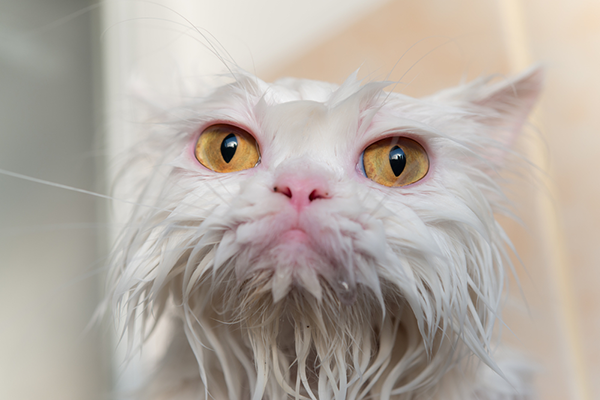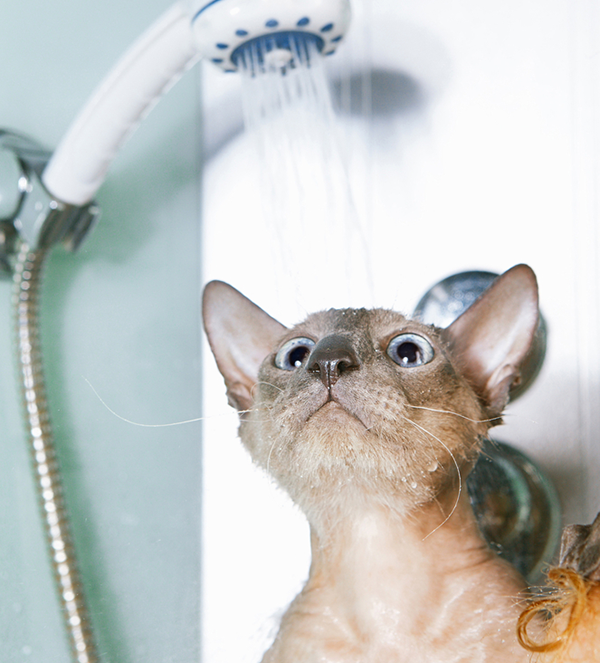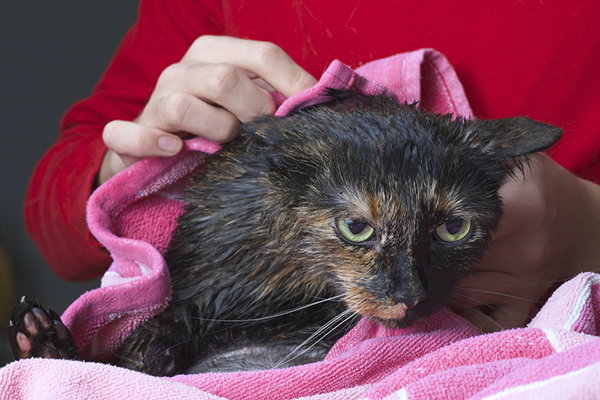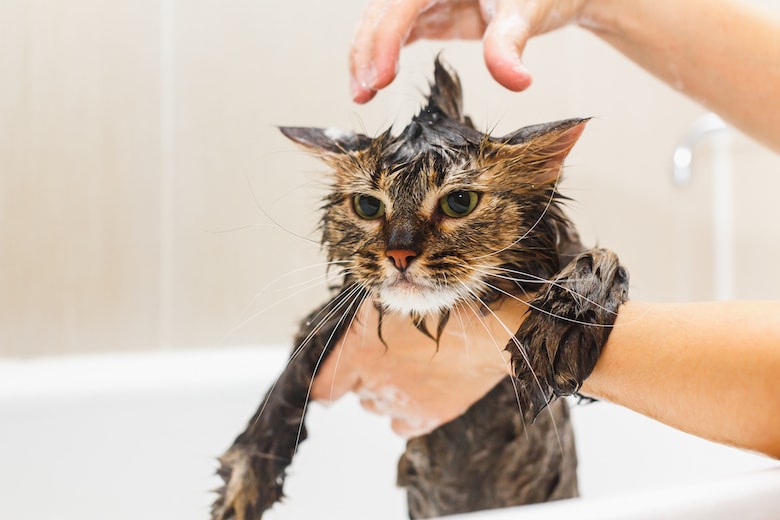The first time I had to bathe a cat, I was 16 years old.
One summer afternoon, our long-haired tuxedo cat, Purr Bear, came into the house covered in grease and other filth, having apparently decided to camp out under a junk car on our property. My mother took one look at him and said, “JaneA, give Purr Bear a bath.”

With visions of deadly combat dancing in my head, I took Purrby into the bathroom, closed the door behind me, and set him in the sink. As the water started running, he didn’t try to flee. In fact, he just kind of sat there. The sink filled, and I waited for the other shoe to drop. Then I started lathering him up with some soap, and I was sure I was going to get shredded. Nope: He just sat there and purred and purred as I scrubbed and rinsed, scrubbed and rinsed.
Ten years later, I had another opportunity to bathe cats. This time it was my tiny kittens, Sinéad and Siouxsie.
I’d been over to a friend’s house about a week before, and apparently I’d brought some unwanted hitchhikers home because one day I noticed that my babies were covered with fleas. They were only about seven weeks old, too young to use topical flea treatments, so the only way I could de-flea them was by bathing them. I got some cat-safe shampoo and set to work, one kitten at a time. They struggled, scrabbled, and tried their hardest to claw me, but they were too small to do any damage. The poor things had to get three baths each (and I had to vacuum and launder everything in my house multiple times) before the fleas were finally gone.
When to bathe your cat

The moral of the story is that although cats are excellent self-groomers, there are times when we do have to intercede. Here are some examples:
- Your cat gets toxic and/or stinky stuff in her fur like Purr Bear did.
- If your cat gets parasites and she’s too young for flea control products like Sinéad and Siouxsie were.
- If your cat is a hairless breed like a Sphynx (these breeds must be bathed every one to two weeks because of oil buildup on the skin).
- Your cat is too overweight to clean herself properly.
- If your cat has medical problems such as arthritis that prevent her from being able to groom well.
- Your cat has a litter box accident and gets some on herself.
The good news is two-fold: a) it’s usually not as hellish to give your cat a bath as you’ve been led to believe; and b) you don’t necessarily have to give your cat a full bath for some of these circumstances. Here are some alternatives to giving your cat a good soaking bath

A washcloth and warm water
For cleaning minor stains or getting food out of your cat’s face fur, dampen a washcloth with warm water and rub in the direction of the fur. Use one finger and mimic the motions of a cat mom licking her babies; chances are your cat will actually enjoy this treatment. A slightly wetter washcloth can help remove poop from your cat’s bloomers.
Use cat wipes
If you’re familiar with baby wipes, cat wipes are the feline version. They’re usually slightly damp and contain cat-safe detergent and conditioners to help remove light dirt, minor stains and the saliva that produces reactions in cat-allergic people. When Siouxsie’s arthritis got to the point that she found it hard to groom herself effectively, I used wipes on her. If you use wipes, be sure to buy only products made for cats, and I recommend unscented wipes if possible.
How to give your cat a dry bath

Dry baths typically come in the form of a powder or foam that you massage into your cat’s fur and leave there. I’ve never used dry baths so I don’t know how well they work, but reviews on a popular online retail site indicate that the foam products work better and are less messy than the powders. Be sure to read the information before using a dry bath because some of these products are supposed to be used only on cats 12 weeks and older. Also, please get dry baths specifically for cats. Dry baths for dogs or other animals may contain products that are toxic to cats.
Have you ever had to give your cat a bath? Have you used cat wipes or dry baths? How did they work? Please share your kitty bathing experiences in the comments.
Top photograph: Alexander Pytskiy/Getty Images
Orginally published in 2016.








